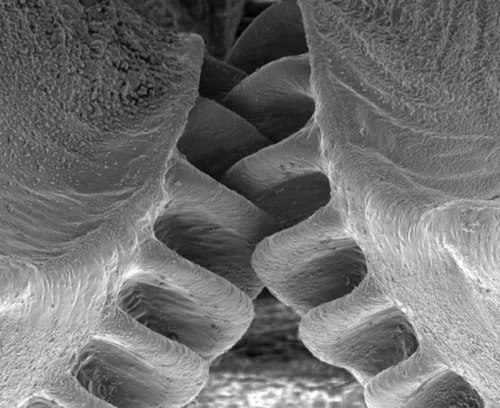Why Do We Not Discuss Clouds More?
Why do we not discuss clouds more?

I mean look at that. That’s water.

Flying water.

FLYING

FUCKING

WATER
LIKE WHAT THE FUCK, WHY DO WE EVER STOP TALKING ABOUT THIS
WHAT IS THIS
HOW IS THIS EVEN

AND NOW THE FLYING WATER IS EATING A MOUNTAIN
GOD DAMN, WHAT
More Posts from Science-is-magical and Others


Close-Up of the First Mechanical Gear Ever Found in Nature
The biological form of a mechanical gear was observed in nature for the first time in juvenile planthoppers (Genus: Issus), a common insect that can be found in gardens across Europe.
The insect has hind-leg joints with curved cog-like strips of opposing ‘teeth’ that intermesh, rotating like mechanical gears to synchronize the animal’s legs when it launches into a jump. The finding demonstrates that gear mechanisms previously thought to be solely man-made have an evolutionary precedent.
(Continue Reading)

An international team of researchers has finally decoded the science behind a plant responsible for no small degree of human misery: poison ivy.
For the first time, we now know why poison ivy leaves – the bane of campers, hikers, and overly curious kids alike – make us itch, and the answer lies in a key molecule called CD1a, which scientists have long known about but didn’t fully understand until now.
“For over 35 years we have known CD1a is abundant in the skin,” says researcher Jerome Le Nours from Monash University in Australia. “Its role in inflammatory skin disorders has been difficult to investigate and until now has been really unclear.”
One of the reasons for that lack of clarity has been that many experiments on skin disorders involve animal testing – specifically lab mice. And mice don’t produce CD1a, effectively creating a kind of ‘blind spot’ in the studies up to this point.
To get around this and examine whether CD1a might play a part in how human skin reacts when we brush up against poison ivy (Toxicodendron radicans) and similar rash-inducing plants, the researchers genetically engineered mice that did produce the molecule.
In doing so, the team found that CD1a – a protein that plays an important role in our immune systems – triggers a skin-based allergic reaction when we come into contact with urushiol, the allergen that functions as the active ingredient in plants like poison ivy, poison oak, and poison sumac.
When urushiol interacts with skin cells called Langerhans cells, the CD1a proteins (which are expressed by Langerhans cells) activate the immune system’s T cells. In turn, the T cells produce two proteins – interleukin 17 and interleukin 22 – which cause inflammation and itchiness.
Continue Reading.

Back in the 1960s, the U.S. started vaccinating kids for measles. As expected, children stopped getting measles.
But something else happened.
Childhood deaths from all infectious diseases plummeted. Even deaths from diseases like pneumonia and diarrhea were cut by half.
“So it’s really been a mystery — why do children stop dying at such high rates from all these different infections following introduction of the measles vaccine,” says Michael Mina, a postdoc in biology at Princeton University and a medical student at Emory University.
Scientists Crack A 50-Year-Old Mystery About The Measles Vaccine Photo credit: Photofusion/UIG via Getty Images
Newly discovered windows of brain plasticity may help with treatment of stress-related disorders
Chronic stress can lead to changes in neural circuitry that leave the brain trapped in states of anxiety and depression. But even under repeated stress, brief opportunities for recovery can open up, according to new research at The Rockefeller University.

(Image caption: Routine versus disruptive: A familiar stressor (left) did not increase NMDA receptors (dark spots), a booster of potentially harmful glutamate signaling, in the brains of mice. However, when subjected to an unfamiliar stress (right), mice expressed more NMDA receptors)
“Even after a long period of chronic stress, the brain retains the ability to change and adapt. In experiments with mice, we discovered the mechanism that alters expression of key glutamate-controlling genes to make windows of stress-related neuroplasticity—and potential recovery—possible,” says senior author Bruce McEwen, Alfred E. Mirsky Professor, and head of the Harold and Margaret Milliken Hatch Laboratory of Neuroendocrinology. Glutamate is a chemical signal implicated in stress-related disorders, including depression.
“This sensitive window could provide an opportunity for treatment, when the brain is most responsive to efforts to restore neural circuitry in the affected areas,” he adds.
The team, including McEwen and first author Carla Nasca, wanted to know how a history of stress could alter the brain’s response to further stress. To find out, they accustomed mice to a daily experience they dislike, confinement in a small space for a short period. On the 22nd day, they introduced some of those mice to a new stressor; others received the now-familiar confinement.
Then, the researchers tested both groups for anxiety- or depression-like behaviors. A telling split emerged: Mice tested shortly after the receiving the familiar stressor showed fewer of those behaviors; meanwhile those given the unfamiliar stressor, displayed more. The difference was transitory, however; by 24 hours after the final stressor, the behavioral improvements seen in half of the mice had disappeared.
Molecular analyses revealed a parallel fluctuation in a part of the hippocampus, a brain region involved in the stress response. A key molecule, mGlu2, which tamps down the release of the neurotransmitter glutamate, increased temporarily in mice subjected to the familiar confinement stress. Meanwhile, a molecular glutamate booster, NMDA, increased in other mice that experienced the unfamiliar stressor. In stress-related disorders, excessive glutamate causes harmful structural changes in the brain.
The researchers also identified the molecule regulating the regulator, an enzyme called P300. By adding chemical groups to proteins known as histones, which give support and structure to DNA, P300 increases expression of mGlu2, they found.
In other experiments, they looked at mice genetically engineered to carry a genetic variant associated with development of depression and other stress-related disorders in humans, and present in 33 percent of the population.
“Here again, in experiments relevant to humans, we saw the same window of plasticity, with the same up-then-down fluctuations in mGlu2 and P300 in the hippocampus,” Nasca says. “This result suggests we can take advantage of these windows of plasticity through treatments, including the next generation of drugs, such as acetyl carnitine, that target mGlu2—not to ‘roll back the clock’ but rather to change the trajectory of such brain plasticity toward more positive directions.”


The Scorpii AR system
In the system AR Scorpii a rapidly spinning white dwarf star powers electrons up to almost the speed of light. These high energy particles release blasts of radiation that lash the companion red dwarf star, and cause the entire system to pulse dramatically every 1.97 minutes with radiation ranging from the ultraviolet to radio.
The star system AR Scorpii, or AR Sco for short, lies in the constellation of Scorpius, 380 light-years from Earth. It comprises a rapidly spinning white dwarf, the size of Earth but containing 200,000 times more mass, and a cool red dwarf companion one third the mass of the Sun, orbiting one another every 3.6 hours in a cosmic dance as regular as clockwork.
Read more at: cosmosmagazine / astronomynow
-
 ohfallingstar reblogged this · 4 weeks ago
ohfallingstar reblogged this · 4 weeks ago -
 rosie-b reblogged this · 1 month ago
rosie-b reblogged this · 1 month ago -
 my-getawaycar reblogged this · 1 month ago
my-getawaycar reblogged this · 1 month ago -
 autistfucks liked this · 1 month ago
autistfucks liked this · 1 month ago -
 casey-rox666 liked this · 3 months ago
casey-rox666 liked this · 3 months ago -
 fearless-stormclaw reblogged this · 3 months ago
fearless-stormclaw reblogged this · 3 months ago -
 bluekid-stardrop liked this · 4 months ago
bluekid-stardrop liked this · 4 months ago -
 dennastalker liked this · 5 months ago
dennastalker liked this · 5 months ago -
 dragonsrreblogers1 reblogged this · 6 months ago
dragonsrreblogers1 reblogged this · 6 months ago -
 dragonsrepic1 liked this · 6 months ago
dragonsrepic1 liked this · 6 months ago -
 lookinggoodinplaid reblogged this · 6 months ago
lookinggoodinplaid reblogged this · 6 months ago -
 ithinktoomuchaboutcats reblogged this · 6 months ago
ithinktoomuchaboutcats reblogged this · 6 months ago -
 ithinktoomuchaboutcats liked this · 6 months ago
ithinktoomuchaboutcats liked this · 6 months ago -
 f4y3w00d5 reblogged this · 6 months ago
f4y3w00d5 reblogged this · 6 months ago -
 the-bearer-of-bad-ideas reblogged this · 8 months ago
the-bearer-of-bad-ideas reblogged this · 8 months ago -
 laithtarvin liked this · 10 months ago
laithtarvin liked this · 10 months ago -
 dro-kage reblogged this · 10 months ago
dro-kage reblogged this · 10 months ago -
 dro-kage liked this · 10 months ago
dro-kage liked this · 10 months ago -
 melonmagnet liked this · 10 months ago
melonmagnet liked this · 10 months ago -
 calmmyfears reblogged this · 10 months ago
calmmyfears reblogged this · 10 months ago -
 calmmyfears liked this · 10 months ago
calmmyfears liked this · 10 months ago -
 tryingtobestine reblogged this · 1 year ago
tryingtobestine reblogged this · 1 year ago -
 katynotthekgb liked this · 1 year ago
katynotthekgb liked this · 1 year ago -
 huntressofartemis001 reblogged this · 1 year ago
huntressofartemis001 reblogged this · 1 year ago -
 huntressofartemis001 liked this · 1 year ago
huntressofartemis001 liked this · 1 year ago -
 apparentlyteodora liked this · 1 year ago
apparentlyteodora liked this · 1 year ago -
 lettis-novaturient liked this · 1 year ago
lettis-novaturient liked this · 1 year ago -
 fairydollie liked this · 1 year ago
fairydollie liked this · 1 year ago -
 kazeharuhime liked this · 1 year ago
kazeharuhime liked this · 1 year ago -
 remarkable-reptiles liked this · 1 year ago
remarkable-reptiles liked this · 1 year ago -
 honeyhouses liked this · 1 year ago
honeyhouses liked this · 1 year ago -
 snapetalon liked this · 1 year ago
snapetalon liked this · 1 year ago -
 blysse-and-blunder liked this · 1 year ago
blysse-and-blunder liked this · 1 year ago -
 these-conquered-woodlands reblogged this · 1 year ago
these-conquered-woodlands reblogged this · 1 year ago -
 these-conquered-woodlands liked this · 1 year ago
these-conquered-woodlands liked this · 1 year ago -
 greens-your-color reblogged this · 1 year ago
greens-your-color reblogged this · 1 year ago -
 ittybittybattyreblogs reblogged this · 1 year ago
ittybittybattyreblogs reblogged this · 1 year ago -
 ittybittybattyart liked this · 1 year ago
ittybittybattyart liked this · 1 year ago -
 froglover69420 liked this · 1 year ago
froglover69420 liked this · 1 year ago -
 leieryx reblogged this · 1 year ago
leieryx reblogged this · 1 year ago -
 arcticfoxtrap reblogged this · 1 year ago
arcticfoxtrap reblogged this · 1 year ago -
 sasharosewater liked this · 1 year ago
sasharosewater liked this · 1 year ago -
 scary-friend liked this · 1 year ago
scary-friend liked this · 1 year ago -
 amethystblooddragon liked this · 1 year ago
amethystblooddragon liked this · 1 year ago -
 ciorohanreme liked this · 1 year ago
ciorohanreme liked this · 1 year ago -
 zanyeggangelcalzone liked this · 1 year ago
zanyeggangelcalzone liked this · 1 year ago




















